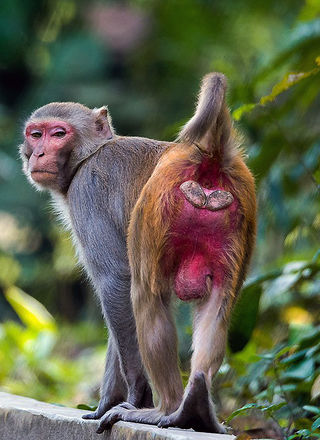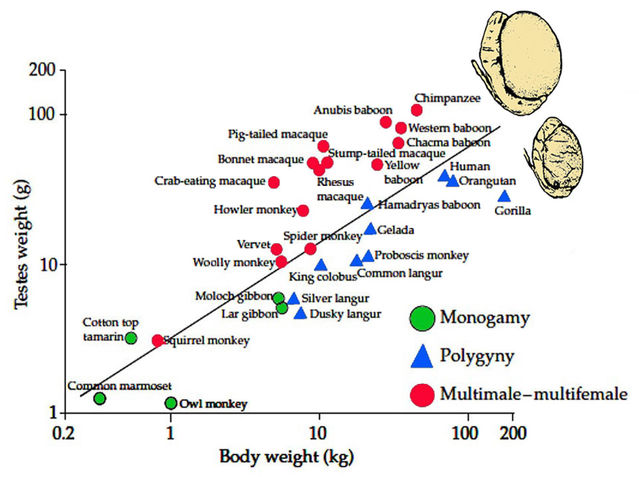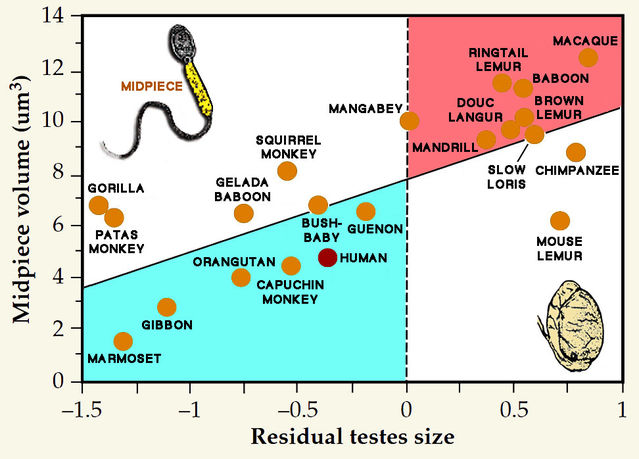Mating
Do Men Have the Balls for Promiscuity?
Research on testes yields clear guides to human mating biology.
Posted May 23, 2018 Reviewed by Ekua Hagan
As this blog enters its sixth year, choosing the next topic is sometimes difficult. Only rarely does a suitable theme turn up of its own accord. An e-mail message challenging my previous blog post ("Monogamy Anchored in Our Genes?" posted April 30, 2018) was therefore fortuitous:
“You have it wrong on human sperm competition. Human testicles are much larger than would be the case if there were not sperm competition. Compare to truly monogamous or harem holding species. I will not engage further on an email discussion of this, for it is very well known among behavioral ecologists.”
At first, I was frustrated to see my carefully compiled account thus dismissed outright, with no mention of alternative evidence and blanket rejection of any discussion. But my dismay gave way to the realization that I had skimmed over the extensive comparative evidence regarding human mating adaptations yielded by studies of testes. My anonymous critic is surely not alone in accepting human sperm competition despite the complete absence of convincing indicators, and I owe it to my readers to set the record straight. In so doing, I am reminded of Thomas Huxley’s famous aside, triggered by Bishop Wilberforce’s mockery of evolution: "The Lord hath delivered him into mine hands."
Testis size and mating system
Like many other biological features, testis volume increases with body size across mammals. Comparisons between species of major very different body sizes must therefore allow for scaling effects. But the relationship between testis size and body size is non-linear, so a simple ratio is misleading. Because testis size increases less rapidly than body size, the ratio will tend to decrease as mammals become larger.

In 1938, Adolph Schultz, my illustrious predecessor as Director of the Anthropological Institute at the University of Zürich in Switzerland, published a pioneering study of testis size in 17 non-human primate species and humans. His truly “seminal” paper was a mine of useful information but left non-linear scaling unmentioned. In fact, the data clearly show an overall trend, with the testis-to-body size ratio decreasing at larger body sizes. For instance, a two-pound owl monkey has a ratio of 0.12%, while the ratio for a 12-pound Javan gibbon is distinctly lower at only 0.08%. Yet both species are monogamous and owl monkey testes actually turn out to be particularly small when appropriate adjustment is made for body size. And some striking points are obvious even without intricate calculations. For instance, a 20-pound adult male macaque has testes weighing close to three ounces, whereas testes of a 7-fold heavier adult man weigh under two ounces!
Several decades elapsed before the connection between testis size and mating system was recognized. In 1979, Roger Short started the ball rolling (so to speak) by considering differences among great apes in relation to their mating systems. Great apes do not differ greatly in body size, so explicit allowance for size effects was not essential. Short noted that male chimpanzees, which live in promiscuously mating multimale-multifemale groups containing several adults of both sexes, have notably large testes. Their testes are three times bigger than in orangutans and four times bigger than in gorillas, both of which have single-male mating. In fact, male orangutans and, especially, male gorillas are considerably heavier than male chimpanzees, so relative to body size the difference is even more marked.

Scaling of testis size to body size
To be fully informative, comparisons across species require appropriate allowance for body size effects. In 1981, Alexander Harcourt and colleagues conducted a wide-ranging examination of relationships between testis weight, body weight, and mating systems across monkeys and apes. Their results clearly confirmed that the mating system is associated with testis size. As expected, across species testis weight generally tends to increase with body size. However, species living in multimale-multifemale groups — including howler monkeys, macaques, plains baboons, and chimpanzees — all have relatively large testes, lying above the overall best-fit line. There is almost no overlap with males living in single-male groups — including both monogamous pairs (e.g., marmosets, owl monkeys, and gibbons) and polygynous harems (e.g., langurs, gelada baboons and gorillas) — which typically have relatively small testes and mostly lie below the line.
As Alan Dixson emphasizes in his 2009 book Sexual Selection and the Origins of Human Mating Systems, men clearly have far smaller testes than male chimpanzees, despite our larger body size. Whereas a human testis is walnut-sized, a chimpanzee testis is as big as a really large chicken’s egg. Small testes conflict with any suggestion that humans are biologically adapted for promiscuous mating. Indeed, judged on size alone, human testes are apparently adapted for a one-male mating system without notable sperm competition between men. Human testes are closely similar in size to those of orangutans, which live virtually solitary lives in a dispersed kind of harem system, with the home range of a fully adult male commonly overlapping with smaller ranges of two or more females. As Dixson’s authoritative 2012 overview Primate Sexuality concludes: “In human males, the testes are not large in relation to body weight; they are much smaller both absolutely and relative to body weight than those of the chimpanzee and resemble the condition found in the orangutan.” Although male gorillas have even smaller testes relative to body size than orangutans or humans, only chimpanzees lie above the best-fit line.
Beyond testis size
Evolutionary interpretations based on testis size and other dimensions of the male reproductive organs are based on a tacit assumption that these features are genetically determined and relatively unaffected by environmental conditions. Yet it is known that in primate species with a restricted breeding season testis size typically varies greatly across the year. A 1980 paper by Jean Wickings and Eberhard Nieschlag reported a threefold annual variation in testis size in Rhesus macaques. Pronounced seasonal variation might explain why, in a plot of testis size against body size, the squirrel monkey, which lives in multimale-multifemale groups, lies close to the best-fit line rather than clearly above it. Squirrel monkeys have a clearly defined breeding season, so it is crucial whether testis size was measured at an appropriate time.
Matt Anderson and Alan Dixson neatly circumvented the issue of environmental influence on testis size by examining the sperms themselves. In all mammals, sperm has a head containing the nucleus, a midpiece packed with mitochondria, and a whip-like propulsive tail. Midpiece mitochondria provide energy to power the tail. Dixson and Anderson reasoned that in promiscuously mating species the sperm midpiece should be bigger, equivalent to a larger fuel tank.

As expected, a plot of midpiece size against relative testis size in various primate species reveals a clear correlation. Promiscuously mating species such as baboons, macaques, and plains baboons lie in the upper right sector of the graph because they have large sperm midpieces as well as relatively large testes. By contrast, the lower left sector of the plot contains various primates with single-male mating systems, such as marmosets, gibbons and orangutans. These species have small sperm midpieces as well as relatively small testes. Importantly, humans fall into that lower sector and are actually quite similar to orangutans. This considerably strengthens the inference that humans are biologically adapted for a single-male mating system.

Despite the fairly strong correlation between midpiece size and relative testis size across primates, scatter in the plot indicates that these two measures can vary independently. Remember that gorillas have notably small testes, even compared to other primates living in single-male groups. However, gorillas have one of the largest sperm midpieces recorded for harem-living primates, considerably larger than in human or orangutan sperms, which rank among the smallest found in primates. It is also noteworthy that the seasonally breeding squirrel monkey, which reportedly has only moderately large testes, has a relatively large sperm midpiece.
In sum, the evidence from relative testis size and sperm midpiece size consistently indicates that men are not biologically adapted for promiscuous mating accompanied by sperm competition. Findings from sperm midpiece size are particularly persuasive because sperm dimensions show little variation in humans and are presumably under tight genetic control.
References
Anderson, M.J., Chapman, S.J., Videan, E.N., Evans, E., Fritz, J., Stoinski, T.S., Dixson, A,F. & Gagneux, P. (2007) Functional evidence for differences in sperm competition in humans and chimpanzees. American Journal of Physical Anthropology 134:274-280.
Anderson, M.J. & Dixson, A.F. (2002) Motility and the midpiece in primates. Nature 416:496.
Dixson, A.F. (2009) Sexual Selection and the Origins of Human Mating Systems. Oxford: Oxford University Press.
Dixson, A.F. (2012) Primate Sexuality: Comparative Studies of the Prosimians, Monkeys, Apes and Human Beings (Second Edition). Oxford: Oxford University Press.
Harcourt, A.H., Harvey, P.H., Larson, S.G., & Short, R.V. (1981) Testis weight, body weight and breeding system in primates. Nature 293:55-57.
Kappeler, P.M. (1997) Intra-sexual selection and testis size in strepsirhine primates. Behavioral Ecology 8:10-19.
Schultz, A.H. (1938) The relative weights of the testes in primates. Anatomical Record 72:387-394.
Short, R.V. (1979) Sexual selection and its component parts, somatic and genital selection, as illustrated by man and the great apes. Advances in the Study of Behavior 9:131-158.
Short, R.V. (1985) Species differences in reproductive mechanisms. Pp. 24-61 in: Reproduction in Mammals, Volume 4: Reproductive Fitness. (eds. Austin, C.R. & Short, R.V.) Cambridge: Cambridge University Press.
Wickings, E.J. & Nieschlag, E. (1980) Seasonality in endocrine and exocrine function of the adult rhesus monkey (Macaca mulatta) maintained in a controlled laboratory environment. International Journal of Andrology 3:87-104.
Anderson, M.J. & Dixson, A.F. (2002) Motility and the midpiece in primates. Nature 416:496.
Dixson, A.F. (2009) Sexual Selection and the Origins of Human Mating Systems. Oxford: Oxford University Press.
Dixson, A.F. (2012) Primate Sexuality: Comparative Studies of the Prosimians, Monkeys, Apes and Human Beings (Second Edition). Oxford: Oxford University Press.
Harcourt, A.H., Harvey, P.H., Larson, S.G., & Short, R.V. (1981) Testis weight, body weight and breeding system in primates. Nature 293:55-57.
Kappeler, P.M. (1997) Intra-sexual selection and testis size in strepsirhine primates. Behavioral Ecology 8:10-19.
Schultz, A.H. (1938) The relative weights of the testes in primates. Anatomical Record 72:387-394.
Short, R.V. (1979) Sexual selection and its component parts, somatic and genital selection, as illustrated by man and the great apes. Advances in the Study of Behavior 9:131-158.
Short, R.V. (1985) Species differences in reproductive mechanisms. Pp. 24-61 in: Reproduction in Mammals, Volume 4: Reproductive Fitness. (eds. Austin, C.R. & Short, R.V.) Cambridge: Cambridge University Press.
Wickings, E.J. & Nieschlag, E. (1980) Seasonality in endocrine and exocrine function of the adult rhesus monkey (Macaca mulatta) maintained in a controlled laboratory environment. International Journal of Andrology 3:87-104.




